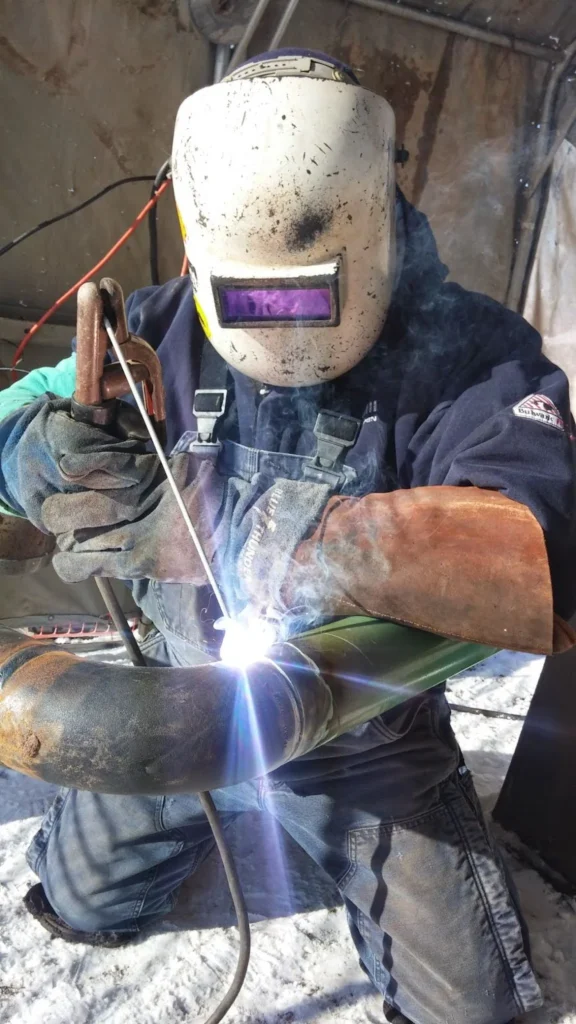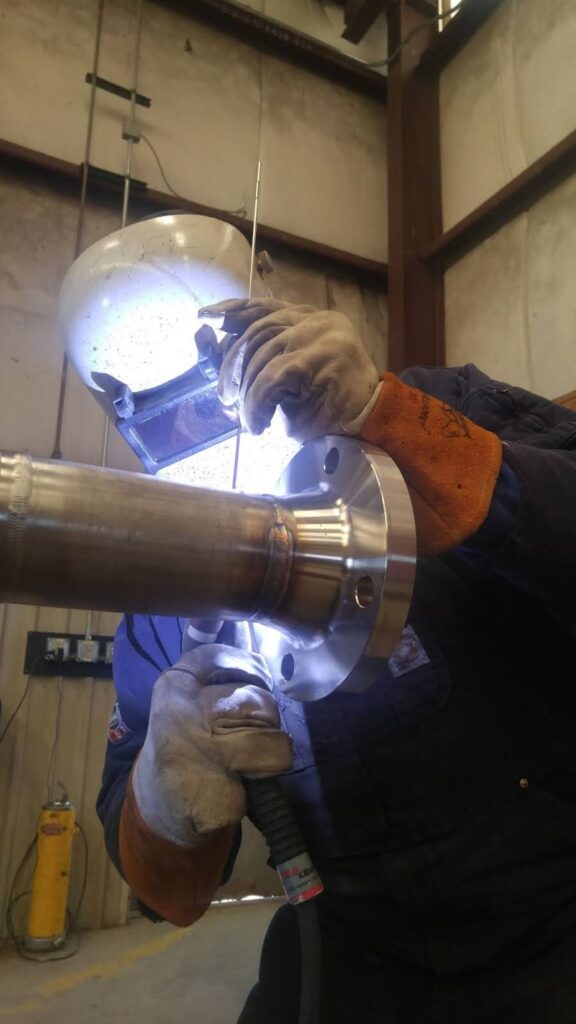In the world of industrial fabrication, understanding common welding processes is crucial for achieving high-quality results. From Shielded Metal Arc Welding (SMAW) and Gas Tungsten Arc Welding (GTAW) to Gas Metal Arc Welding (GMAW) and beyond, each welding technique offers unique advantages and applications. At Scott Process, we leverage these processes to ensure our projects meet the highest standards of precision and durability. In this article, we explore the various welding methods, their benefits, and the factors that influence the choice of the right process for your specific needs.
SHIELDED METAL ARC WELDING (SMAW) OR STICK WELDING
Shielded Metal Arc Welding, commonly known as Stick Welding, remains a fundamental technique in the welding industry due to its simplicity and versatility.
- Simplicity of Equipment: SMAW requires minimal equipment—just a power source, lead cable, and ground.
- Portability: The lightweight “stinger” or electrode holder is easy to move, allowing welders to cover large areas.
- Ease of Learning: Welders can quickly master the SMAW process.
- Operator Control: Welders can adjust travel speed, arc length, and rod angle to manage weld joint inconsistencies.
- Outdoor Capability: SMAW can be performed in harsh, remote conditions where other methods might not be feasible.
- Versatility: Suitable for welding a wide array of metals, including stainless steel and aluminum, and various joint configurations.
- Any Position: SMAW can be used in nearly any position if the electrode is rated for out-of-position welding.
However, stick welding has limitations, such as lower electrode efficiency and the need to remove slag from the weld.

GAS TUNGSTEN ARC WELDING (GTAW) OR TUNGSTEN INERT GAS (TIG) WELDING
TIG welding is favored for high-quality welds, especially on aluminum, stainless steel, and nickel alloys.
- Operator Control: Welders can precisely control the weld joint.
- Clean Welds: TIG produces welds that require minimal post-weld cleaning.
- Versatility: Suitable for a variety of metals and joint configurations.
- Position Flexibility: Can be used in any welding position.
Limitations include the slower process and the need for meticulous pre-weld cleaning due to susceptibility to impurities.
GAS METAL ARC WELDING (GMAW) OR METAL INERT GAS (MIG) WELDING
MIG welding is prevalent due to its versatility and ease of use.
- High Deposition Rates: Efficient for various materials.
- Semi-Automatic Process: Enhances weld consistency.
- Efficient Electrode Use: Minimal waste of electrode and filler metals.
- Position Flexibility: Effective out-of-position welding.

However, MIG welding requires shielding gas, making it less suitable for outdoor use, and it is sensitive to surface contaminants.
FLUX-CORED ARC WELDING (FCAW)
Similar to MIG welding, FCAW offers higher deposition rates and deep-penetrating welds, making it ideal for thicker materials.
- High Deposition Rates: Efficient for heavy-duty welding.
- Consistency: Semi-automatic process ensures consistent welds.
Drawbacks include susceptibility to porosity, especially in drafty environments, and the need to clean the resulting slag.
SUBMERGED ARC WELDING (SAW)
SAW is an automated process ideal for high productivity in production facilities.
- High Deposition Rates: Efficient for welding thicker metal sections.
- Consistent Quality: Automated process produces uniform welds.
Limitations include restricted welding positions, expensive equipment, and post-weld slag cleaning.
ELECTRON-BEAM WELDING (EBW)
EBW uses a concentrated beam of high-velocity electrons to create deep-penetrating welds with minimal heat input.
- Versatility: Suitable for nearly all metals, including alloy combinations.
- Deep Penetration: Lower heat input results in a smaller heat-affected zone.
The primary disadvantage is the high cost, making EBW suitable only for specific applications.
Factors Influencing the Choice of Common Welding Processes
MATERIAL TYPE
Different materials require specific welding processes. For instance, carbon steel can be welded with most methods, while stainless steel and aluminum may need specialized equipment and electrodes.
MATERIAL THICKNESS
Thicker materials benefit from high deposition rate processes like FCAW, whereas thinner sections might require MIG or TIG welding to prevent distortion and burn-through.
WELDING POSITION
Certain processes are better suited for specific positions. SMAW and TIG offer high operator control, making them ideal for complex joint configurations and out-of-position welding.
JOINT DESIGN AND PROJECT SPECIFICATIONS
Joint design dictates the choice of welding process. SMAW and TIG are suitable for CJP welds, while FCAW is advantageous for thick plate fillet welds.
WELDING SPEED AND PRODUCTIVITY
For high productivity, processes like FCAW and SAW with high deposition rates are preferable. SMAW’s need for frequent electrode changes can reduce efficiency.
ENVIRONMENTAL CONDITIONS
Outdoor welding in windy conditions favors SMAW due to its robustness against environmental factors. Clean environments may require low-fume processes like TIG.
Deciding on the Right Welding Process
- Understand the Project Requirements: Assess the project’s demands, including load, stress, and failure consequences.
- Assess Skills: Match the process to the welder’s expertise.
- Consider Equipment Availability: Evaluate available equipment and its suitability.
- Review Cost and Efficiency: Consider both initial costs and consumable expenses.
- Perform Tests and Trials: Test the chosen process on sample pieces to ensure it meets project requirements.
Advancements in Common Welding Processes Technology
- Laser Welding: Combining laser with other processes for enhanced speed and control.
- Automation: Increasing efficiency and safety through reduced human error and exposure.
- Future Trends: Growing use of robotics and augmented reality in training.
Understanding these welding processes and their applications can significantly enhance the efficiency and quality of welding projects at Scott Process.